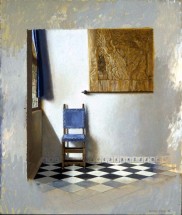Vermeer's Chair
| Date: | 1994
|
| Medium: | Oil on canvas |
| Size inches: | 28 x 24 |
| Size cm: | 71.1 x 61
|
| Signature: | Signed and dated lower right |
| |
| Location: | Private Collection, Address Unknown |
...taking as his point of departure several Vermeers, among them Y
oung Woman with Pearl Necklace (c. 1664), the artist creates a new "Vermeer" while staying as close as possible to the original's style, painting technique, and color harmony. There is a subtle irony in
Vermeer's Chair in the way that this chair is inaccessibly placed to the left, in the corner of a spare Vermeerian interior that to the right appears to come forward toward the beholder, and then gradually dissolves into the abstract self-evidence of the canvas. While thus visualizing the difficulty of understanding Vermeer's places he also suggests that as painter, that is in the process of painting, he can temporarily hold his place in a Vermeer. Perhaps more than any other of Deem's many "Vermeers,"
Vermeer's Chair, in its simplicity, pays homage to the seventeenth-century painter. (Christiane Hertel,
Vermeer: Reception and Interpretation, Cambridge University Press, 1996).
Click highlighted words for image and information
In
Vermeer's Chair I reduced my quotation of Vermeer to two elements that recur in his paintings: a windowed wall at the left (the source of light in the painting) and, at a right angle to that wall, a wall with a hanging map. My interest was to emphasize the magic corner of the room, which is at the core of Vermeer's work. I eliminated from my painting both the various objects in Vermeer's interiors and the human figure. The room is empty of movable objects except for a single chair, shown in frontal view, standing between the window wall and the map. It is a chair that is never fully seen in Vermeer's paintings. Only the extreme top of the chair is visible against the wall in
Woman with a Pearl Necklace (c. 1664). Half of the chair, in frontal view, is visible in
The Geographer (c. 1668-69). Although Vermeer presents only partial views of this chair in his paintings, an example of the actual chair, preserved in the Town Hall at Delft, may be seen in P.T.A. Swillens's
Johannes Vermeer, Painter of Delft 1632-75 (Plate 54: a chair made in 1661, upholstered with tapestry by Maximiliaan van der Gucht). The window wall, with the hanging mirror and the yellow curtain, is from
Woman with a Pearl Necklace. The map is a map of Europe from Vermeer's
Woman with a Lute (c. 1664). The blue-and-white Delft tiles at the base of the wall are from Vermeer's
A Lady Standing at a Virginal (c. 1670-72). In early 1996 I completed a companion painting
Vermeer's Blue Chair. The two paintings are the same size, 28 x 24 inches. (George Deem, New York, February 17, 1996).
"Vermeer's Blue Chair" is a companion painting to my 1994 painting, "Vermeer's Chair." The two paintings are the same size, 28 by 24 inches. In "Vermeer's Chair" I isolated a chair seen in partial view in Vermeer's paintings "Woman with a Pearl Necklace" and "The Geographer." The chair is seen in its entirety for the first time in my painting "Vermeer's Chair."
In "Vermeer's Blue Chair" I have isolated another chair seen only in partial view in Vermeer's "Woman in Blue Reading a Letter" (Rijksmuseum, Amsterdam). The same chair is seen again behind the table in Vermeer's "The Music Lesson," in the Queen's Collection, London. I have presented the entire chair in a frontal view and eliminated other elements in Vermeer's paintings, including the figure.
In my painting the rear wall with the map of Holland is from Vermeer's "Woman in Blue Reading a Letter." I have filled in the area of the map, which was not visible behind the figure of the woman, by reference to another painting by Vermeer, "Officer and Laughing Girl" (Frick Collection, New York) which includes the identical map.
The window wall to the left with the blue curtain is from Vermeer's "Woman with a Lute" in the Metropolitan Museum, New York. The tile floor is from the same painting and, because it is not visible in Vermeer's painting, I have extended the tile floor to the left in my painting.
The blue and white tiles at the base of the walls are from Vermeer's "A Lady Standing at a Virginal" in the National Gallery in London.
(George Deem, New York, February 15, 1996)
I am very much involved with Vermeer these days, a series of paintings in which I de-construct paintings by Vermeer. I depict his interiors with their familiar furniture and windows but I have taken away his figures. These paintings come from
Moving Vermeer where I first took away Vermeer's figures to make the background. It was after painting the background that I got the idea for
Vermeer's Chair. The enclosed postcard shows the image, the same image in the back panel of
Moving Vermeer. (George Deem, letter to Garland and Suzanne Marshall, May 11, 1998).



